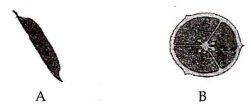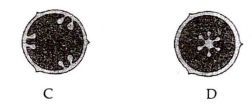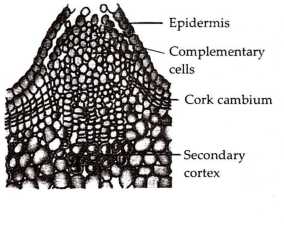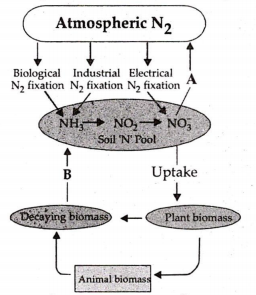 Multiple Choice Questions
Multiple Choice QuestionsBacteria, fungi, lower plants survive in adverse conditions by
diapause
suspended growth
migration
formation of thick walled spores.
Identify the given figures A, B, C, D and E.



| A | B | C | D | E |
| Marginal | Axile | Free central | Parietal | Basal |
| A | B | C | D | E |
| Marginal | Parietal | Free central | Axile | Basal |
| A | B | C | D | E |
| Marginal | Axile | Parietal | Free central | Basal |
| A | B | C | D | E |
| Marginal | Axile | Parietal | Basal | Free central |

structure of lenticel
hydathode showing gaseous vapour exchange
fungus reproducing by spore formation
algae reproducing by spore formation.
A.
structure of lenticel
The figure shows structure of lenticel which facilitates gaseous exchange and transpiration. These are aerating pores in the bark of woody trees. These are surrounded by loosely arranged thin walled complementary cells enclosing intercellular spaces for gaseous exchange.
In the given diagram A and B represent

| A | B |
| Mineralisation | Demineralisation |
| A | B |
| Ammonification | Denitrification |
| A | B |
| Denitrification | Ammonification |
| A | B |
| Denitrification | Mineralisation |
In active transport, carrier proteins are used, which use energy in the form of ATP, to
transport molecules against concentration gradient of cell wall.
transport molecules along concentration gradient of cell membrane.
transport molecules against concentration gradient of cell membrane.
transport molecules along concentration gradient of cell wall.
In a 50 gm living tissue, what would be the amount of water
15- 25 gm
25 - 30 gm
35- 45 gm
70- 90 gm
After glycolysis, fate of glucose in mitochondrial matrix is
oxidation
reduction
oxidative decarboxylation
hydrolysis
Cleistogamy is leading over anthesis because
pollination agent is not required
it assures heterozygosity
it favours insect pollination
it allows xenogamy
